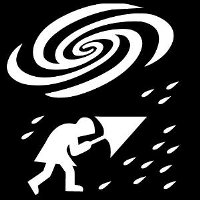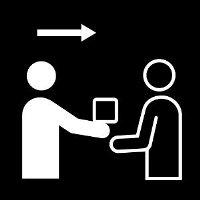Establishment of Design Principles of Pictorial Symbols to support people with Communication Disabilities(July 2005)
Japanese Society for Rehabilitation of Persons with Disabilities (JSRPD)
Ministry of Economy, Trade and Industry (METI) established "Design principles of pictorial symbols for communication support (JIS T0103)" on April 20, 2005, to serve elderly and people with disabilities who have difficulties in verbal and written communication, people involved in education, supporters and ordinary people.
Each school for children with disabilities or community created individual pictorial symbols, which are easy to understand for people with intellectual disabilities, and has been using them as a communication support or education tool. Such differences in designs between schools or communities, however, caused users inconvenience and unification of symbols had been awaited. A more than 10-year study revealed that pictorial representation (symbols) is effective for persons/children with intellectual disabilities, but a lack of expertise in designing hampered the realization of the unification of symbols.
 Under these circumstances, METI started a three-year contract operation to draft a JIS standard for pictorial symbols for communication support in 2000. In June 2003 a committee to finalize the draft for pictorial symbols for communication support was established within Japanese Standards Association (JSA). The committee, composed of members from government and industries, as well as expertise in various fields such as design, education, engineering, met every two months. Since no such standard existed in Japan, members visited Canada, Australia and Sweden to study not only designs but issues such as rights for people with disabilities and how pictorial symbols were used. They found that the Swedish system which can be used by anyone freely was informative and they searched for the way to adapt it to the situation in Japan. The collection of about 300 pictorial symbols included in the Appendix to the standard is strictly for the purposes of reference only, and the focus of standardization is to define design principles.
Under these circumstances, METI started a three-year contract operation to draft a JIS standard for pictorial symbols for communication support in 2000. In June 2003 a committee to finalize the draft for pictorial symbols for communication support was established within Japanese Standards Association (JSA). The committee, composed of members from government and industries, as well as expertise in various fields such as design, education, engineering, met every two months. Since no such standard existed in Japan, members visited Canada, Australia and Sweden to study not only designs but issues such as rights for people with disabilities and how pictorial symbols were used. They found that the Swedish system which can be used by anyone freely was informative and they searched for the way to adapt it to the situation in Japan. The collection of about 300 pictorial symbols included in the Appendix to the standard is strictly for the purposes of reference only, and the focus of standardization is to define design principles.
 Firstly, the members selected categories to be included in the standard, based on the survey results of "degree of importance to life" and carried out active discussions on designs. Then they checked students' understanding of the proposed designs in several schools for children with disabilities. Even after such efforts, however, it was difficult to reach a consensus and designs that can be understood easily by relatively many people were selected. Members also carefully discussed how to express each category, including names (such as family, face and intersection), feelings (such as affection, boredom and sadness) and actions (wash one's face, run and throw away). Special attention was paid to designing facial expressions to avoid having people (children) with intellectual disabilities misunderstand the meaning of the pictorial symbols.
Firstly, the members selected categories to be included in the standard, based on the survey results of "degree of importance to life" and carried out active discussions on designs. Then they checked students' understanding of the proposed designs in several schools for children with disabilities. Even after such efforts, however, it was difficult to reach a consensus and designs that can be understood easily by relatively many people were selected. Members also carefully discussed how to express each category, including names (such as family, face and intersection), feelings (such as affection, boredom and sadness) and actions (wash one's face, run and throw away). Special attention was paid to designing facial expressions to avoid having people (children) with intellectual disabilities misunderstand the meaning of the pictorial symbols.
 Regarding the next step in establishing the standard, Masahiro Sato from Standardization Office for Consumers and Environment of METI explains as follows; "It is necessary to increase the number of pictorial symbols because 300 is not enough for everyday communication. It is also necessary to create a network to spread information and educate people about the standard, and not only indirect approaches including using media but direct approaches to the end-users are important. We will promote the newly established JIS T0103 to the world market and have it adopted as an ISO standard."
Regarding the next step in establishing the standard, Masahiro Sato from Standardization Office for Consumers and Environment of METI explains as follows; "It is necessary to increase the number of pictorial symbols because 300 is not enough for everyday communication. It is also necessary to create a network to spread information and educate people about the standard, and not only indirect approaches including using media but direct approaches to the end-users are important. We will promote the newly established JIS T0103 to the world market and have it adopted as an ISO standard."
Design principles of pictorial symbols for communication support (JIS T0103) is available at the web site of Kyoyo-Hin Foundation. The Foundation says there have been inquiries about pictorial symbols from distribution industry, educational institutions, municipalities and families of children with disabilities since the establishment of the standard in April. Cooperation between the parties concerned such as governments, educational institutions, welfare workers and private companies will be necessary to disseminate it.
Download the Design principles of pictorial symbols for communication support (JIS T0103) at the following URL;
Kyoyo-Hin Foundation
Inquiry:
jimukyoku@kyoyohin.org
References
JIS T0103 "Design principles of pictorial symbols for communication support" by Japanese Standards Association (JSA) 2005
